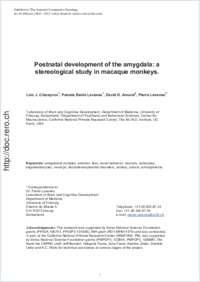Postnatal development of the amygdala: A stereological study in macaque monkeys
- Chareyron, Loïc J. Laboratory of Brain and Cognitive Development, Department of Medicine, University of Fribourg, Switzerland
- Banta Lavenex, Pamela A. Laboratory of Brain and Cognitive Development, Department of Medicine, University of Fribourg, Switzerland
- Amaral, David G. Department of Psychiatry and Behavioral Sciences, Center for Neuroscience, California National Primate Research Center, The M.I.N.D. Institute, UC Davis, USA
- Lavenex, Pierre Laboratory of Brain and Cognitive Development, Department of Medicine, University of Fribourg, Switzerland
-
16.12.2011
Published in:
- The Journal of Comparative Neurology. - 2012, vol. 520, no. 9, p. 1965-1984
amygdaloid complex
emotion
fear
social behavior
neurons
astrocytes
oligodendrocytes
neuropil
neurodevelopmental disorders
anxiety
autism
schizophrenia
English
Abnormal development of the amygdala has been linked to several neurodevelopmental disorders, including schizophrenia and autism. However, the postnatal development of the amygdala is not easily explored at the cellular level in humans. Here, we performed a stereological analysis of the macaque monkey amygdala in order to characterize the cellular changes underlying its normal structural development in primates. The lateral, basal and accessory basal nuclei exhibited the same developmental pattern, with a large increase in volume between birth and three months of age, followed by slower growth continuing beyond one year of age. In contrast, the medial nucleus was near adult size at birth. At birth, the volume of the central nucleus was half of the adult value; this nucleus exhibited significant growth even after one year of age. Neither neuronal soma size, nor neuron or astrocyte numbers changed during postnatal development. In contrast, oligodendrocyte numbers increased substantially, in parallel with an increase in amygdala volume, after three months of age. At birth, the paralaminar nucleus contained a large pool of immature neurons that gradually developed into mature neurons, leading to a late increase in the volume of this nucleus. Our findings revealed that distinct amygdala nuclei exhibit different developmental profiles and that the amygdala is not fully mature for some time postnatally. We identified different periods during which pathogenic factors might lead to the abnormal development of distinct amygdala circuits, which may contribute to different human neurodevelopmental disorders associated with alterations of amygdala structure and functions.
- Faculty
- Faculté des sciences et de médecine
- Department
- Département de Médecine
- Language
-
- English
- Classification
- Biological sciences
- License
- License undefined
- Identifiers
-
- RERO DOC 28767
- DOI 10.1002/cne.23023
- Persistent URL
- https://folia.unifr.ch/unifr/documents/302253
Statistics
Document views: 118
File downloads:
- lav_pda.pdf: 187
